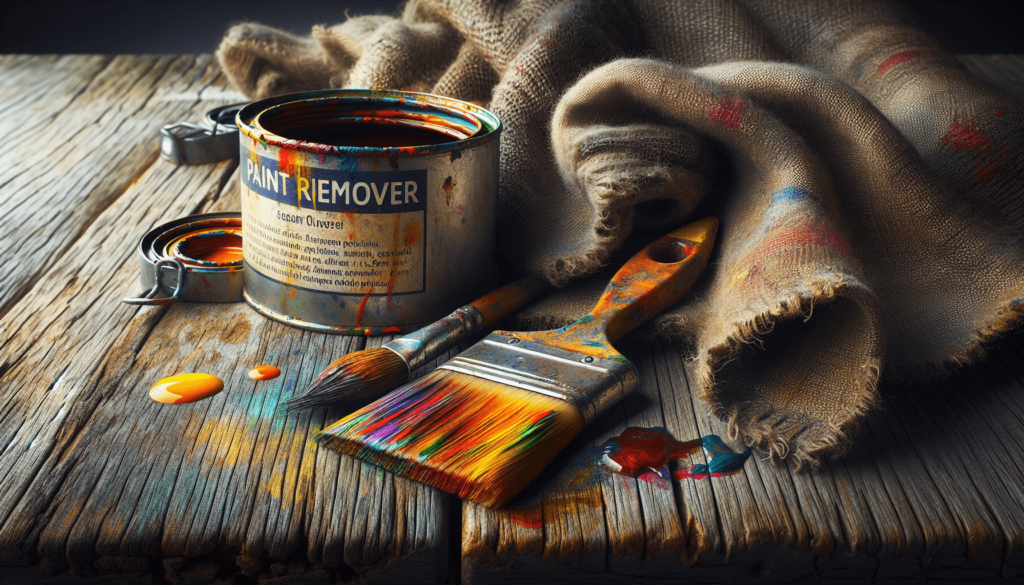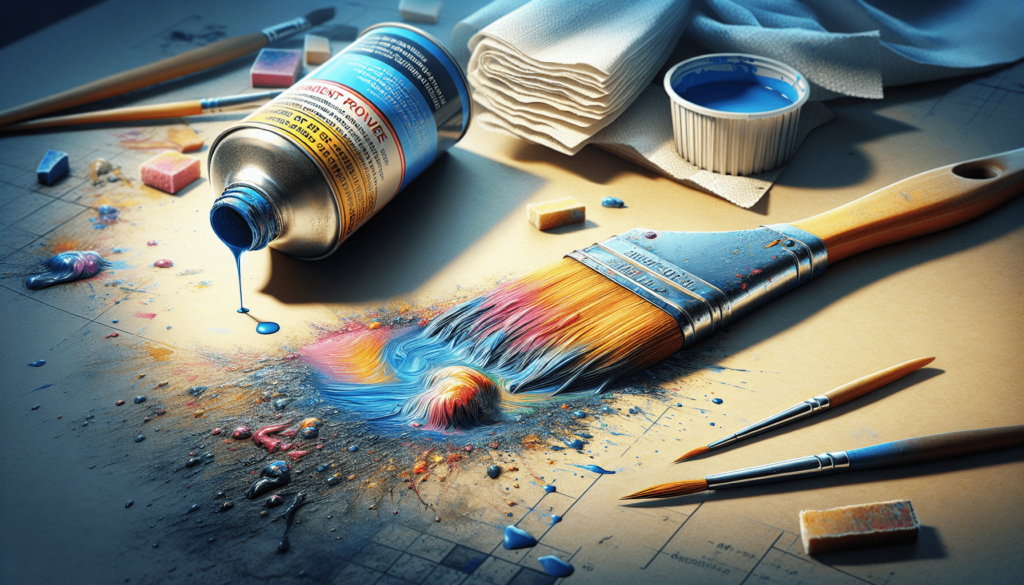Understanding how to safely and effectively remove oil paint from various surfaces can be an invaluable skill, especially if you’re frequently engaged in DIY or art projects. This article provides you with an array of effective strategies and techniques to get rid of unwanted oil paint, whether it’s newly split or has dried up over time. Your problem with persistent oil paint stains is about to efficaciously meet its solution, ensuring a cleaner, stain-free environment.

Preparation
Before proceeding to deal with oil paint, it’s vital to put necessary measures in place. This stage involves the readiness of physical and mental states to ensure safe and efficient handling of paint.
Gather necessary materials
With the task at hand, it’s important that you gather up all the materials you need. This might include soap, brush cleaner, paint remover or solvent, a brush or sponge, a clean cloth, heavy-duty detergent, mild dish detergent, and stain remover. Precision is required to carry out the task effectively, and it’s easier to work when all your tools are within reach.
Protect your surroundings
Since the process of removing oil paint can get messy, it’s essential to take steps to protect your surroundings. Put a tarp or a drop cloth down to safeguard your floor or carpet. It’s also prudent to clear off any valuable items or furniture that might get tarnished in the process.
Wear protective clothing
It’s equally critical for you to put on protective clothing like an apron or old clothes that you don’t mind getting dirty. Do not forget to wear your rubber gloves – they will help to guard your skin against any irritating chemicals.
Removing Wet Oil Paint
One might accidentally spill oil paint while working on a project. The steps taken in the immediate aftermath are crucial to ensure the successful removal of the paint.
Blot excess paint with a clean cloth
The first response should be to blot the spilled paint with a clean cloth. However, make sure you do so gently to prevent the paint from spreading further.
Use a mild dish detergent solution
Next, create a solution of warm water and mild dish soap. This mixture effectively breaks down the oil in the paint, therefore making it easier to remove.
Scrape off the remaining paint gently
Ensure that you have a blunt knife or a paint scraper available. Use it to carefully remove any clinging paint from the surface. Be gentle to avoid damaging the surface.
Wash the area with warm soapy water
After scraping off the excess paint, wash the area thoroughly. Use warm water with enough soap. Be sure to clean all crevices where paint could have found its way into.
Repeat if necessary
Sometimes, one round of cleaning might not get the job done. If this happens, don’t despair. Simply repeat the process until you achieve the desired results.
Removing Dried Oil Paint
Dried oil paint presents more of a challenge but is not impossible to remove.
Scrape off as much paint as possible
Use a blunt knife or paint scraping tool to gently scrape off as much paint as you can. It’s important not to apply too much pressure to avoid damaging the surface underneath the paint.
Apply a paint remover or solvent
Once you’ve removed the bulk of the paint, apply a liberal amount of a paint remover or solvent. Make sure to follow the usage directions provided by the manufacturer.
Let it sit for a few minutes
Work the paint remover or solvent into the paint stain and let it sit for a few minutes. The oil paint should start to soften and dissolve.
Scrub the area with a brush or sponge
Once the paint has softened, use a brush or sponge to scrub away at the paint. Be careful not to scrub too hard, or you may damage the surface.
Wipe away the dissolved paint
Use a clean cloth or sponge to wipe away the dissolved paint. If you’re not careful, you can end up spreading the paint and creating a more extensive stain.
Clean the surface with soapy water
After removing all traces of the paint, rinse the area thoroughly with warm, soapy water. This will clean away any residual paint remover or solvent.
Removing Oil Paint from Clothing
By following these steps diligently, removing oil paint from clothes can be hassle-free.
Act quickly
If you notice paint on your clothing, it’s important to act quickly. The sooner you start to remove the paint after it happens, the easier it will be to get it out.
Blot the excess paint gently
Do not rub the paint into the fabric. Instead, blot gently using a clean cloth or paper towel to lift as much paint as possible without spreading it.
Pre-treat the stain with a stain remover
Use a commercial stain remover, following the instructions on the packaging. This will help to break down the paint before washing, making it easier to remove.
Wash the garment with a heavy-duty detergent
After pre-treating the stain, wash the garment with a heavy-duty laundry detergent. Ensure to check the washing instructions on the clothes label to avoid spoiling your article of clothing.
Check if the stain is completely gone before drying
Before drying the clothes, check to make sure that the stain has been fully removed. If the stain persists, repeat the process. Drying the clothing with the stain still present will set the stain and make it more challenging to remove.

Removing Oil Paint from Brushes
A brush is a valuable tool for a painter, and its maintenance is key. Play close attention to your brushes, and follow these steps for cleaning them.
Clean brushes immediately after use
To maintain their effectiveness, clean your brushes promptly after use. This prevents the paint from drying on the brushes, which would make them much harder to clean.
Use a brush cleaner or mineral spirits
Apply a brush cleaner or mineral spirits, working it into the bristles to break down the paint. Once the paint begins to dissolve, you can move on to the next step.
Rinse the brushes under warm water
Give your brushes a good rinse under running warm water. Continue rinsing until the water runs clear, and you are certain all paint has been removed.
Reshape the bristles and leave them to dry
After rinsing, reshape your brushes’ bristles to their original form and leave them to dry thoroughly. Store them appropriately to maintain their shape and increase their lifespan.
Repeat if necessary
For brushes with dried paint, the process may have to be repeated. Persistent washing and rinsing can save your brushes from being ruined.
Removing Oil Paint from Surfaces
The technique for removing oil paint varies depending on the surface. Here’s a general guide for most surfaces.
Protect the surrounding areas
Depending on the affected surface’s location, it might be necessary to protect the surrounding areas to prevent them from getting marred by any cleaning agents or scraped-off paint.
Scrape off excess paint gently
Try to get rid of as much excess paint as possible to simplify the cleaning process. Use broad, gentle strokes with the scraper to prevent any unwanted damage.
Apply a paint thinner or remover
Apply a generous amount of paint thinner or remover onto the stain. Follow the manufacturer’s instructions for the specific product you use.
Let it sit for a few minutes
Don’t rush the process. The paint thinner or remover needs time to penetrate the paint and react with it.
Scrub the surface with a brush or sponge
After soaking the area, scrub thoroughly using a brush or sponge. Avoid scrubbing too hard to maintain the surface’s integrity.
Wipe away the dissolved paint
With a damp cloth, wipe away the loosened paint. Again, patience is fundamental to prevent any damage to the surface by ensuring all paint is completely removed.
Clean the surface with soapy water
Finally, clean the area with warm soapy water to ensure all the residues are washed off.
Preventing Oil Paint Accidents
Think safety first and take these preventative measures to minimize the risk of accidents when using oil paint.
Cover surfaces with plastic or newspaper
To protect your workspace, cover all surfaces with a plastic sheet or newspaper. This way, any accidental spills or splashes are probably caught before they can cause any harm.
Use drop cloths or tarps
You can protect the surrounding areas using drop cloths or tarps. They’re easy to clean and reusable.
Keep paint containers tightly closed
This minimises spill accidents that may occur from tipped over containers.
Work in a well-ventilated area
Since some paint and cleaning substances can produce strong odors, it’s vital to work in a well-ventilated area. This will help to significantly reduce the risk of experiencing respiratory problems.
Avoid wearing loose clothing
It’s sensible to avoid wearing loose clothing when painting. Loose clothes could easily brush against the wet paint, causing unwanted accidents.
Have a spill cleanup kit ready
A spill cleanup kit with all the necessary cleaning materials should be present. It’s easier to perform quick and efficient cleanup when all the materials are easily accessible.
Disposing of Oil Paint
Proper disposal of oil-based paint is crucial, not just for efficient waste management, but also for environmental preservation.
Check local regulations
Disposal regulations vary from place to place. It’s imperative to check and understand local regulations before attempting to dispose of paint.
Allow paint to dry completely
Wet paint is viewed as a hazardous material in some locations. Allow any leftover paint to dry out completely before the disposal process commences.
Put hardened paint in a sealed garbage bag
Once the paint has dried completely, it can safely be put into a sealed garbage bag before being put into your regular waste bin.
Contact local waste disposal authorities
When in doubt, contact your local waste disposal authorities. They’ll guide you on how best to dispose of your leftover oil paint.
Seeking Professional Help
In instances where oil paint stains prove too stubborn or cover a large area, it might be wise to seek professional help.
Evaluate the situation
Analyse and evaluate the full extent of the problem. Weigh the pros and cons of a DIY cleanup versus getting professional help.
Contact professional cleaning services
If the situation demands, don’t hesitate to reach out to cleaning services in your locality. They are equipped with the necessary tools and knowledge to handle large-scale paint spillages.
Follow their instructions
Once you’ve made contact with the professionals, ensure to follow their advice and instructions. This will guarantee that the job gets done effectively and safely.
Conclusion
Dealing with oil paint successfully requires proper knowledge and techniques. Taking preventive measures to avoid accidents goes a long way in ensuring a smooth painting experience. Dispose of oil paint responsibly to help keep our environment clean and safe. And remember, professional help is always there if you find yourself in a tough situation.



